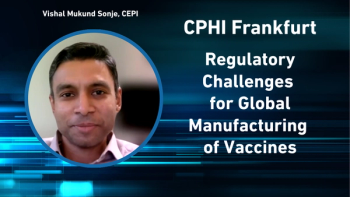
- Pharmaceutical Technology-12-02-2016
- Volume 40
- Issue 12
Bridging Gaps in the Global Regulatory Framework
Better co-ordination within and between regions is needed to improve the global regulation of medicines, according to the European Medicines Agency.
A report by the European Medicines Agency (EMA) on the international regulation of medicines has pinpointed major deficiencies in the collaboration among regulators in tackling worldwide problems in the management of pharmaceuticals. Regulators are aware of the need for co-ordination within and between regions, which has led to a “myriad of initiatives,” according to the report (1) by EMA, the London-based European Union body responsible for licensing drugs for the whole of the EU market as well as running the EU’s network of national medicines agencies.
“The fundamental question is not if the medicine regulators worldwide need to co-operate but how they can best co-operate in order to achieve the desired results,” says the report, which is one of the first of its kind to provide an overview of the current international regulatory activities in medicines. Because of an inconsistency in how to achieve effective co-operation, the initiatives lack “integration and strategic direction ... often leading to overlap or duplication of activities.” In addition, gaps have opened up in the scope of collaboration so that key issues can be excluded. This fragmentation could become worse amidst signs that economic globalization has peaked, as reflected in the Brexit vote in the United Kingdom’s recent referendum and the outcome of the United States presidential election, although this is a question not covered by the EMA report.
The role of ICMRA
The study (1), which was conducted in the form of a mapping exercise on international initiatives, was requested by the three-year-old International Coalition of Medicine Regulatory Authorities (ICMRA), a organization representing heads of medicines agencies of which EMA is a leading founder member. Many of the ICMRA members, such as EMA, consider the association to be an important means of resolving the problems of the global control of pharmaceuticals because it can operate strategically by setting worldwide objectives in priority areas relating to the availability, quality, and safety of medicines. “ICMRA is unique due to its high level of membership among heads of agencies, which is necessary to develop and ensure global strategic leadership and co-ordination,” an EMA spokesperson told Pharmaceutical Technology Europe.
Among the essential matters that need to be managed more effectively on a global basis are disruptions to supply chains and responses to crises when there is an urgent need for medicines such as vaccines as a result of serious outbreaks of infectious diseases. The report highlights the impact of new, complex technologies such as advances in biotechnology, gene editing, and cell therapies. “Manufacturing phases of a medicine may now be carried out in different countries or even different continents and a medicine may often be distributed in multiple regions,” the report says (1). ICMRA has projects covering generic medicines, GMP, rapid sharing of information between agencies, supply-chain integrity, crisis management, and pharmacovigilance.
The pharmaceutical industry sees ICMRA as an opportunity for influencing the international regulation of medicines after its role within the Geneva-based International Council for Harmonization of Technical Requirements for Pharmaceuticals for Human Use (ICH) was downgraded. After a restructuring of ICH in 2015, the industry found that its ideas on reliability of electronic records and standards for track-and-trace systems for pharmaceuticals had more opportunity of being realized elsewhere.
“We discovered that it was better to pursue [these proposals] via ICMRA instead,” said a spokesman for the European Federation of Pharmaceutical Industries and Associations (EFPIA). “The pharmaceutical industry is global and has, therefore, a unique opportunity to identify arising issues early and contribute to the strategic global co-ordination strategy,” he added.
Initiatives by other organizations
In addition to considering the activities of ICMRA itself, EMA looked at initiatives by a range of organizations, some of them operating globally and others regionally such as the EU itself and the Council of Europe’s European Directorate for the Quality of Medicines & Healthcare (EDQM). A total of approximately 20 initiatives were covered by the study. Some organizations, mainly those with a global scope, are well established bodies. These organizations include the World Health Organization (WHO) with its Essential Medicines and Pharmaceutical Policies (EMP) scheme, covering medicines policy, quality assurance, and medicines access throughout the world.
The Paris-based Organization for Economic Co-operation and Development (OECD) provides policy analysis and data for developed countries on health policies and draws up standards for R&D and testing processes in pharmaceuticals and biotechnology. Organizations such as ICH, set up in 1990, are more narrowly focused on harmonization and the development of common standards in pharmaceuticals. The Geneva-based Pharmaceutical Inspection Co-operation Scheme (PIC/S) concentrates on creation and maintenance of GMP standards, particularly through the training of inspectors. The International Generic Drug Regulators Programme (IGDRP), launched in 2012, is focused on harmonizing controls of generic medicines to ensure their greater availability across the world.
The numbers of regional initiatives have been growing steadily. Asia now has the Asia-Pacific Economic Co-operation’s (APEC) projects on harmonization and guidelines in the life-sciences and medical products industries. The Association of Southeast Asian Nations (ASEAN) has its own pharmaceutical products working group dealing with the harmonization of medicines regulation. Africa has the African Medicines Regulatory Harmonization (AMRH) programme. But within the continent, there are a number of sub-regional harmonization initiatives such as those covering East Africa and parts of southern Africa.
In the Americas, the Pan-American Network for Drug Regulatory Harmonization (PANDRH) promotes harmonization in drug assessments and approvals. The Ibero-American Medicines Authorities Network (EAMI) is one of the few organizations to forge links between two continents-in this case Latin America and the Iberia area of Europe, comprising Spain and Portugal. It is mainly a forum for exchange of information and developing best practices, such as in the formulation of medicines prepared in pharmacies.
Work sharing and current priorities
With most international initiatives, the primary objective is the exchange of information, which is followed by the setting of standards and best practices. The next collaborative stage is usually work sharing. Europe is the only region where a high level of work sharing also coexists with a system of mutual recognition, under which an approval of a drug or medicine improvement by one agency would be recognized by licensing agencies in other regional countries. Many states across the world balk at mutual recognition because of fears about loss of autonomy.
The thinking behind EMA’s study (1) of international regulatory activities is that a global overview helps to provide the basis for the creation of strategies that should eventually lead to the elimination of overlaps and duplication while also filling gaps in current initiatives. As a result, ICMRA’s approach has been to set priority areas and then use an overview of what is happening in these among regulators internationally to provide a basis for strategies to be drawn up on each one of them by the organization.
EMA’s task was to use its report (1) to give overviews of three of ICMRA’s current priorities-supply-chain integrity, crisis management, and pharmacovigilance. With 14 different initiatives covering supply chain integrity, EMA found overlaps in the use of databases, track-and-trace schemes, and warning systems. Among the gaps was a lack of mutual awareness among regulators, inability to link systems, and to leverage different projects.
“Despite multiple track-and-trace initiatives on a national or regional basis that share a common aim, none of them seem to have looked beyond their borders,” the report says. A major problem is that despite international agreement on a global standard for the identification of medicinal products, it is still a long way from being integrated into national or regional databases. So when there are international supply-chain difficulties, regulators cannot be sure they are referring to the same product.
With the issue of crisis management, there is a lack of common understanding among regulators about what a health crisis means, according to the study. EMA has proposed in the report a definition that a health crisis occurs when routine measures are not considered sufficient after an analysis of an incident’s associated risks. However, among the urgent and co-ordinated actions needed to control a crisis, there is no systematic international mechanism for dealing with shortages of specific medicines caused by manufacturing problems or natural disasters. Nor, the report says, is there a systematic means for the involvement of regulators in helping to tackle outbreaks of infectious diseases, such as Ebola, when there could be an urgent requirement for new medicines or vaccines.
Effective pharmacovigilance on an international scale is being held back by similar trends in supply-chain integrity-such as lack of awareness among regulators of other international schemes for reporting adverse reactions to drugs or quality issues. Identification difficulties because of non-compliance with the international standard on naming medicines was another barrier to proper co-ordination, according to the study.
The EMA’s report has on the whole been welcomed by European pharmaceutical industry associations. But there has been some skepticism about how much regulators need to be involved in matters like supply-chain disruptions.
Medicines for Europe, an association representing generic-medicine manufacturers, warned about the dangers of oversimplifying the matter of medicines availability and shortages. “There are many causes to unavailability, and not all ‘remedies’ will lie in the regulatory arena,” a spokesman for the association told Pharmaceutical Technology Europe. Individual governments, to which regulatory agencies are ultimately accountable, may also decide to take a more direct role themselves in sorting out problems in areas such as supply chain and management of pandemics.
Reference
1. EMA, Connecting the Dots-Towards global knowledge of the international medicine regulatory landscape: mapping of international initiatives (London, October 2016).
Article Details
Pharmaceutical Technology Europe
Vol. 28, No. 12
Pages: 8-9
Citation
When referring to this article, please cite it as S. Milmo, "Bridging Gaps in the Global Regulatory Framework," Pharmaceutical Technology Europe 28 (12) December 2016.
Articles in this issue
almost 9 years ago
Options in Employee Trainingalmost 9 years ago
Biosimilars Supporting Contract Manufacturers’ Growthalmost 9 years ago
Airlocks for cGMP Facilitiesalmost 9 years ago
Evaluating Mixing in a Single-Use Bioprocessing Systemalmost 9 years ago
Shrink Banders for Labeling Applicationsalmost 9 years ago
Chromatograph Enables Fast Recovery of Target Compoundsalmost 9 years ago
Automated Microscope for Multimodal Imagingalmost 9 years ago
From Bitter to Sweet: Developing a User-Friendly Painkilleralmost 9 years ago
Nurturing the Relationship Between Industry and Regulatorsalmost 9 years ago
Getting involved with pharma standardsNewsletter
Get the essential updates shaping the future of pharma manufacturing and compliance—subscribe today to Pharmaceutical Technology and never miss a breakthrough.





